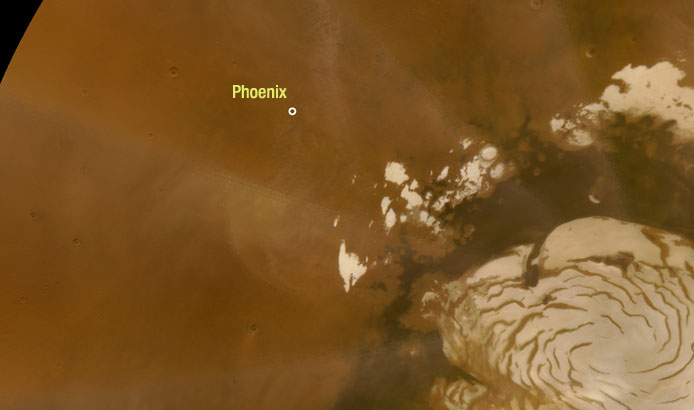[/caption]
The science team for the Phoenix Lander was forced to curtail many of their activities over the weekend because of a regional dust storm that temporarily lowered the lander’s solar power. But Phoenix weathered the storm well, and the team is back investigating the Red Planet’s northern plains. The 37,000 square-kilometer storm (nearly 23,000 miles) moved west to east, and weakened considerably by the time it reached the lander on Saturday, Oct. 11. The science team was expecting the worst, so this tamer storm put the spacecraft in a better than expected situation, said Ray Arvidson of Washington University in St. Louis, the lead scientist for Phoenix’s Robotic Arm.
The lander is now back to busily collecting samples and weather data, analyzing the soil samples, and conducting other activities before fall and winter stop Phoenix cold.
“Energy is becoming an issue, so we have to carefully budget our activities,” Arvidson said.
The Phoenix team tracked the dust storm last week through images provided by the Mars Reconnaissance Orbiter’s Mars Color Imager. The imager’s team estimated that after the dust storm passed through Phoenix’s landing site on Saturday, the dust would gradually decrease this week.
This dust storm is a harbinger of more wintry and volatile weather to come. As Martian late summer turns into fall, the Phoenix team anticipates more dust storms, frost in trenches, and water-ice clouds. They look forward to collecting data and documenting this “most interesting season,” Arvidson said.
Source: Phoenix News Site


It’s good to have a weather forecast in a dusty world…
“37,000 square-kilometer storm (nearly 23,000 miles)”
does this make sense? should it be somthing like
“37,000 square-kilometer storm (nearly 12,000 square miles)”
anhow, I’ve been following Phoenix’s exploits with fascination from the beginning – it’s so much better than TV, especially these last couple of months…
oops, sorry, in my previous post: for “12,000”, please read “15,000” – I’m World Champion at making typos…
😉
Meh, 12k 15k 23k .. i think BIG, Damn BIG, is the general impression we are supposed to take away 🙂
Do all Mars storms look like a beautiful, surging, pint of Guinness? I think me likey…
The band of dark green surrounding the polar cap – Earl Slipher and the other pre-1964 astronomers observed this. And they are still not given credit for their dedicated observations. Sure would be nice if the current generation of scientists and astrobiologists could share with us why the exploration of Mars has been so pathetic for decades. I guarantee you I will not stop until I have answers to this and the other open questions (Sinton bands showing organics on Mars, Dollfus’ polarization observations, etc.). I simply don’t trust any scientist with a self-proclaimed bias, but that is the world we’ve inherited. This type of mis-treatment of the public wrt science might have been acceptable in the time of Galileo, but it is utterly unacceptable today. The type of mis-information the public is handed might have been acceptable during the Bay of Pigs, but not today. Any participating scientist should be ashamed.